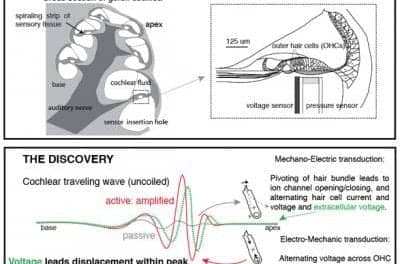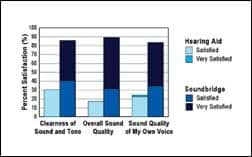Cochlear Limited (ASX: COH) announced that the Cochlear Nucleus 8 Sound Processor received US Food and Drug Administration (FDA) approval. The Nucleus 8 Sound Processor is now “the smallest and lightest behind-the-ear cochlear implant sound processor available in the industry.”1-3 It is also “the world’s first cochlear implant sound processor ready to provide direct audio connectivity to everyday consumer electronics using the next generation LE Audio technology from Bluetooth®”.1-3,
The Nucleus 8 Sound Processor features Cochlear’s latest and most innovative hearing technology that can sense changes in a person’s environment and automatically adjust their listening settings.4-7* It also includes an enhanced ForwardFocus+ feature, which effectively reduces distracting background noise to make face-to-face conversations clearer, especially in noisy environments.8 ^ Cochlear continues its commitment to reduce the size of each processor generation with the new behind-the-ear sound processor being 15% smaller and 13% lighter than its predecessor.9,±
“Cochlear’s goal is to help people feel empowered to connect with their world and make it easier to hear and be heard,” said Lisa Aubert, President, Cochlear Americas. “In a restaurant, at work, at school, or spending time with family and friends – life’s full of opportunities to engage with others. The Nucleus 8 Sound Processor is our smallest, lightest, and smartest behind-the-ear sound processor yet and is designed to help people hear conversations more clearly and comfortably, wherever life may take them.”

The Nucleus 8 Sound Processor builds on the direct streaming capabilities available in Cochlear’s latest sound processors. With access to next-generation Bluetooth LE Audio, it will be “easier than ever to directly connect to everyday technology in more places and from more devices than ever before.”10-12 #
“Cochlear continues to lead in innovation that matters most, delivering smaller and smarter sound processors to improve hearing performance that’s comfortable and easy to use,” said Ryan Lopez, Director, Nucleus Product Management & Marketing, Cochlear Americas. “The Bluetooth LE Audio connectivity in the Nucleus 8 Sound Processor will provide those with hearing loss new, more convenient ways to stream audio to their sound processor, including making it easier for children and adults to engage in the world around them. From the classroom to the conference room, we want to help reduce the stress of life’s interactions with the Nucleus 8 Sound Processor.”
In addition to the Nucleus 8 Sound Processor, Cochlear is expanding its Connected Care solutions for Nucleus Implant System recipients. Building upon the ability to let cochlear implant recipients adjust their own processor settings and access Remote Care•• options from their mobile phone, enhancements to the Nucleus Smart App will enable future improvements to the bimodal control experience and provide access to Remote Firmware updates, so patients can access the latest technology without a trip to the clinic.
The Cochlear Nucleus 8 Sound Processor received FDA approval and will be commercially available across the United States and Canada by the end of 2022. The Nucleus 8 Sound Processor has been approved by Health Canada.
Disclaimers
- # When the technology becomes available for the Cochlear Nucleus 8 Sound Processor, a firmware update to your sound processor will allow you to connect to Bluetooth LE Audio compatible devices.
- • Compared to Nucleus 6 and 7 Sound Processors.
- + ForwardFocus can only be enabled by a hearing implant specialist. It should only be activated for users 12 years and older who are able to reliably provide feedback on sound quality and understand how to use the feature when moving to different or changing environments. It may be possible to have decreased speech understanding when using ForwardFocus in a quiet environment.
- ^ Compared to Nucleus® 7 Sound Processor with ForwardFocus on.
- ± Comparison made using the Compact Battery Module for Nucleus 8 Sound Processor and the Compact Rechargeable Battery for Nucleus 7 Sound Processor.
- •• Remote Check and Remote Assist are intended for ages 6 and older. Remote Check and Remote Assist features are only visible and accessible if they are enabled by a clinician. Clinicians should consider the suitability of the feature before enabling Remote Check and Remote Assist.
References
- [cited 2022 Feb 28]. Available from: https://www.advancedbionics.com/
- [cited 2022 Feb 28]. Available from: https://www.medel.com/
- [cited 2022 Feb 28]. Available from: https://www.oticonmedical.com/
- Cochlear Limited D1864200 SCAN-X Design Description. Apr 2022.
- Mauger SJ, Warren CD, Knight MR, Goorevich M, Nel E. Clinical evaluation of the Nucleus 6 cochlear implant system: Performance improvements with SmartSound iQ. International Journey Of Audiology. 2014;53(8): 564-576. [Sponsored by Cochlear]
- Mauger SJ, Jones M, Nel E, Dot JD. Clinical outcomes with the Kanso™ off- the-ear cochlear implant sound processor. International Journal Of Audiology. 2017;56(4):267-276. [Sponsored by Cochlear]
- Wolfe J, Neumann S, Marsh M, et al. Benefits of adaptive signal processing in a commercially available cochlear implant sound processor. Otol Neurotol. 2015;36(7):1181-1190. [Sponsored by Cochlear]
- Cochlear Limited. D1964109 Clinical Investigation Report CLTD5804. Feb 2022.
- Cochlear Limited. D1190805, Processor Size Comparison. May 2022.
- Hunn N. Introducing Bluetooth® LE Audio [Internet]. [cited 2022 Jan]. Available from: https://www.bluetooth.com/learn-about-bluetooth/recent-enhancements/le-audio/.
- Cochlear Limited. D1631375 Nucleus 8 Sound Processor Product Definition.
- A Technical Overview of LC3 [Internet]. Bluetooth® Technology Website. [cited 2022 Feb 28]. Available from: https://www.bluetooth.com/blog/a-technical-overview-of-lc3.
Source: Cochlear
Images: Cochlear





